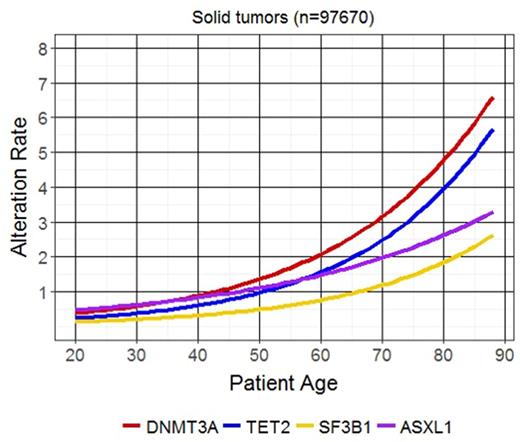Abstract
BACKGROUND:
Molecular testing is inevitably performed on patient samples that include not only the tumor being profiled, but also admixed non-lesional tissue such as benign organ parenchyma, stromal cells, and hematopoietic elements. As people age, hematopoietic stem cells may acquire somatic genomic alterations that result in 'clonal hematopoiesis of indeterminate potential' (CHIP), associated with an increased risk of developing myeloid malignancies. While there are few targeted therapies for CHIP-associated alterations at present, with the notable exception of DNMT3A and hypomethylating agents; it is important to understand the true prevalence of these alterations in solid tumors for future drug development. We hypothesize that CHIP-associated alterations are detected in a subset of solid tumor specimens submitted for genomic profiling.
DESIGN:
97,670 solid tumor samples were evaluated for all classes of genomic alterations using comprehensive genomic profiling (CGP) analysis of 315 genes via DNAseq [FoundationOne® (F1)] or 406 genes via DNAseq and 265 genes via RNAseq [FoundationOne Heme® (F1H)]; 257 genes are interrogated by both assays. Logistic regressions were performed to evaluate the relationship between genomic alterations and patient age, allele frequency, and sample tumor purity.
RESULTS:
Several genes have been previously associated with CHIP, with recurrent genomic alterations described for each gene. Seventeen CHIP-associated genes were interrogated by both F1 and F1H, and eight of these had CHIP-associated alterations in >1% of cases: DNMT3A, TET2, SF3B1, ASXL1, TP53, NRAS, BCOR, and IDH1 . A significant increase in the rate of genomic alterations within DNMT3A, TET2, SF3B1, ASXL1, TP53, and NRAS was observed with increasing patient age across all solid tumors (p values: DNMT3A= 9.1x10-75, TET2= 1.75x10-109, SF3B1= 3.4x10-47, ASXL1= 1.86x10-41, TP53= 1.77x10-19, NRAS= 2.94x10-4, Figure 1). TP53, IDH1, and NRAS were excluded from further analyses due to their known high alteration rate in solid tumors.
Alterations present in hematopoietic elements should correlate with increasing age regardless of tumor type. For all 257 genes tested in F1 and F1H, cases were categorized into 23 disease groups. The log odds ratio of alteration rate for each disease group and gene combination before and after age 60 was calculated. After correction for multiple hypothesis testing, only DNMT3A, TET2, SF3B1, and ASXL1 had significantly more alterations after age 60 across disease groups (p<0.05).
The sensitivity for detection of alterations present in hematopoietic elements should decrease with increasing tumor purity, as this implies the presence of fewer admixed hematopoietic elements. For DNMT3A, TET2, SF3B1, and ASXL1 the rate of alterations in specimens with >=50% tumor purity is significantly lower than in those with <50% tumor purity (DNMT3A : 1.1% vs. 1.8%, p < 2.2x10-16; TET2 : 1.4% vs 2.1%, p < 3.9x10-14; ASXL1, 1.4% vs 1.7%, p < 1.6x10-4; SF3B1, 0.7% vs 1.0%, p<1.4x10-5).
As these genes are altered in patients of all ages within this cohort, we assumed the alterations in young patients are likely present in the tumors, whereas the alterations in elderly patients are likely present in the hematopoietic elements. If this assumption is correct, the allele frequency should decrease from young patients, in which the alterations are unlikely to be secondary to CHIP, compared to older patients for whom CHIP is common. This holds true for DNMT3A, TET2, SF3B1, and ASXL1, when comparing patients <60 y to those >=60y (DNMT3A : 14.7% vs 10.7%, p < 1.3x10-6; TET2 : 21.8% vs 14.0%, p < 3.1x10-16; ASXL1, 21.6% vs 18.3%, p < 6.1x10-7; SF3B1, 20.6% vs 12.9%, p< 2.7x10-13).
CONCLUSIONS:
Molecular testing of solid tumor samples commonly detects genomic alterations present in admixed hematopoietic elements. At age 30 y, the combined alteration rate for DNMT3A, TET2, SF3B1, and ASXL1 is 1.5% and increases with each passing decade: 50 y, 4.0%; 60 y, 5.8%; 70 y, 8.5%; and 80 y, 14.4%. This trend is seen both within and across tumor types. For older patients, alterations in these genes are much more likely to be present in hematopoietic elements than in the solid tumor component. As patients age, CHIP-associated alterations identified in solid tumor samples need to be interpreted carefully for appropriate patient management, and a hematologic workup should be considered in the appropriate clinical context.
Severson: Foundation Medicine: Employment, Other: Stock. Connelly: Foundation Medicine: Employment, Other: stock. Ramkissoon: Foundation Medicine: Employment, Other: stock. Frampton: Foundation Medicine Inc.: Employment, Equity Ownership. Gay: Foundation Medicine: Employment, Other: stock. Daniel: Foundation Medicine: Employment, Other: Stock. Elvin: Foundation Medicine: Employment, Other: Stock. Suh: Foundation Medicine: Employment, Other: Stock. Miller: Foundation Medicine: Employment, Other: Stock. Stephens: Foundation Medicine Inc.: Employment, Equity Ownership. Ali: Foundation Medicine, Inc: Employment, Other: Stock. Ross: Foundation Medicine Inc: Employment, Other: stockholder. Vergilio: Foundation Medicine: Employment, Other: Stock.
Author notes
Asterisk with author names denotes non-ASH members.


